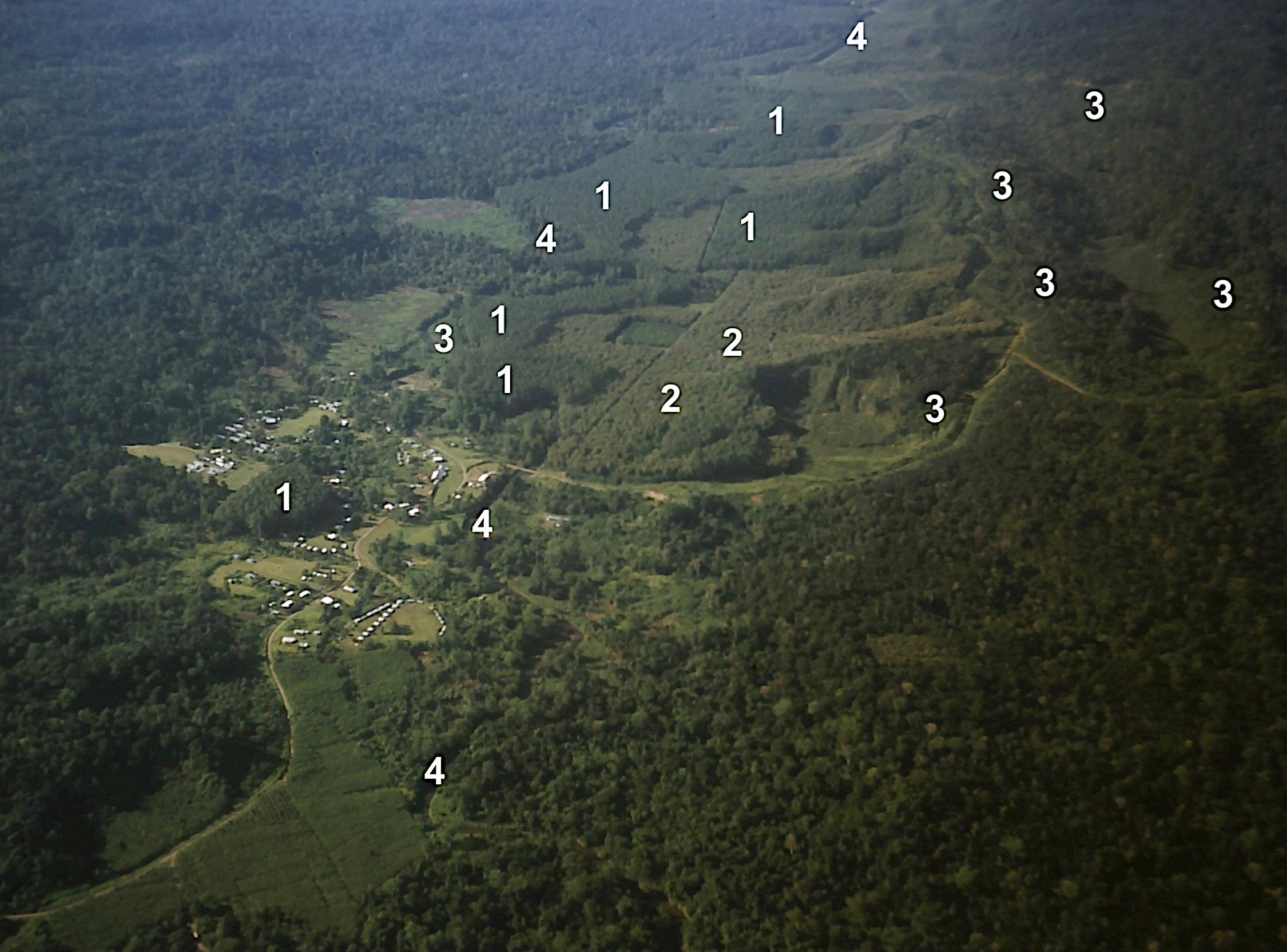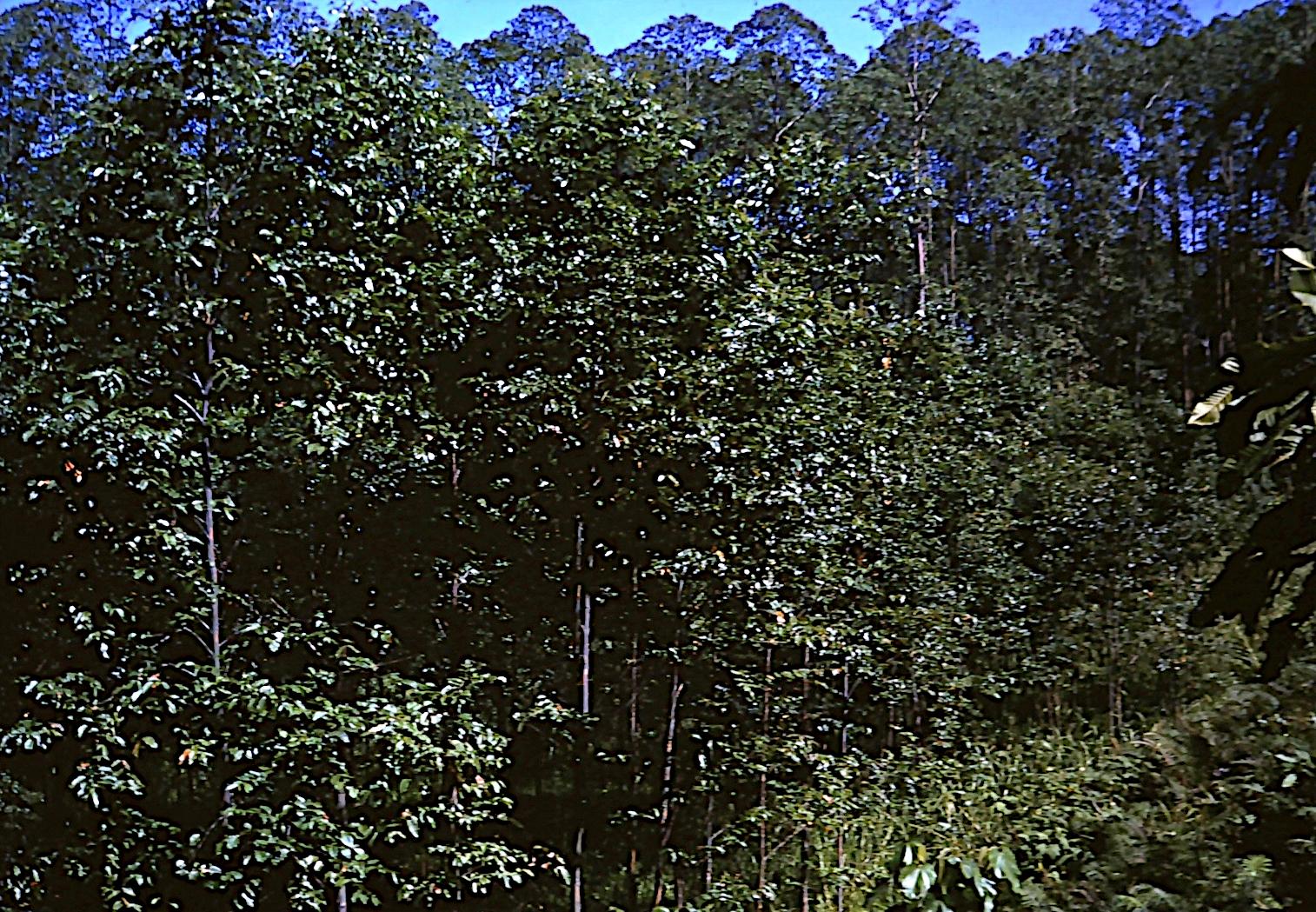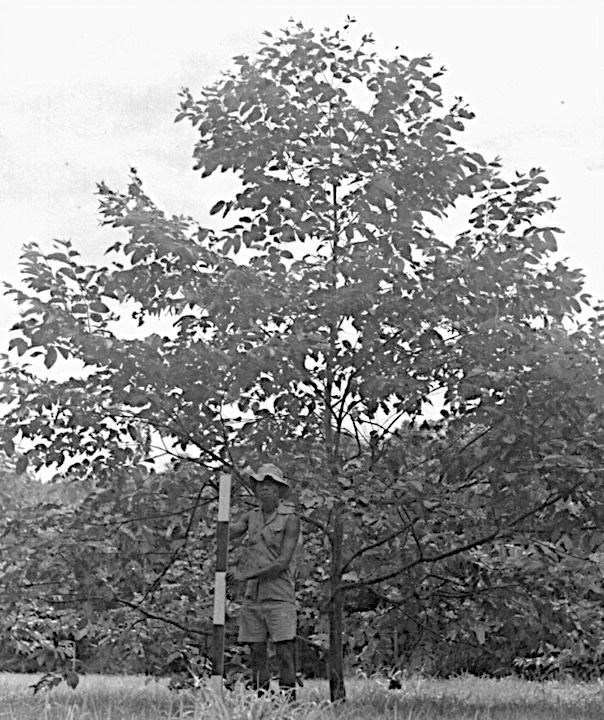
5 minute read
Fieldwork in Keravat
from PNGAF MAG ISSUE # 9B - 5B4D3 Dr John Davidson Accompaniment "RAINBOW EUCALYPT MAN" Part 3 of 8 parts
by rbmccarthy
In a second experiment conducted after more space became available in the phytotron, the five provenances were grown in C-type cabinets at three temperature regimes (21/16, 27/22 and 33/28 °C) and three day lengths (8, 12 and 16 hours) per temperature regime. Eight seedlings were assigned to each temperature-photoperiod cell: temperatures x photoperiods x provenances x replicates = total seedlings 3 3 5 8 360 The plants were grown for 108 days and measurements undertaken as in the preliminary experiment.
Provenance ranking remained the same as before for growth rate. Growth rate of all provenances increased with both increasing temperature and longer day length. An analysis of variance revealed there was no difference for seedling woody tissue density among the five provenances (not significant at the 5% level when the among provenances mean square, with only four degrees of freedom, was tested against an error mean square derived from the sum of all the mean squares containing a replication component).26Despite the limitations of this study I felt confident that any wood density work done on the Keravat provenance could be applied to E. deglupta over most of its natural range.
Advertisement
Fieldwork in Keravat
The Faculty of Science ANU, not wanting to set a precedent for PhD students, grudgingly granted me up to three months leave of absence from Canberra for fieldwork on E. deglupta to be undertaken at Keravat. One of the official conditions was that Kevin White was appointed my interim PhD supervisor for the period. Since the Public Service Commissioner had granted me continuity of service while I was in Canberra, an automatic promotion to Forest Officer Class 2 had taken place on 6 August 197027, and my Scholarship was topped up to that level by the Department of Forests for the 74 days I spent at Keravat 21 October 1970 – 3 January 1971. I was billeted with Heather and Terry Duggan.
One of the first field visits I wanted to make in Keravat was to the cuttings plantation at Vudal. The remainder of my time would be spent with the wood sampling crew, seed collection from selected trees using the rifle and supervision of felling operations for thinning trials and collection of data for volume and yield tables. An assessment was made of the fertilizer trial at age two years.
26 Table 8.3, page 174 In Davidson J 1972 loc. cit. 27 See page 3, Papua New Guinea Gazette No. 44 of 6 August 1970. Because I was out of the country, the Forest Officer Class 2 post was held against a vacant Position No. R.76 in Goroka, which listed duties as: “Assist in direction of forestry extension work. Control timber permits and licences within the area. Carry out special investigations, surveys, etc. Prepare detailed reports. Train subordinate staff.”! According to this same Gazette (on page 4), Rod Holesgrove was promoted at Bulolo on the same day.
Keravat from the air, on descent into Rabaul, 22 October 1970. 1. E. deglupta plantations in which random, candidate and breeding population trees had been selected, 2. Tectona grandis (Teak) plantations, 3. Early examples of encroachment into the plantation areas by squatters for food garden cultivation, 4. Keravat River.
During my visit the remaining trees out of the total of 275 random and candidate trees were sampled for wood density study. The bark to pith samples were packed and airfreighted to Canberra and released to the care of the Forestry Department ANU after fumigation with methyl bromide by Quarantine Officials. Checking for seed on the candidate trees was a regular task. Capsule laden branches when found were shot down, the capsules stripped and dried in the sun to release the seed. Seed of individual trees was kept separate, labelled, sealed in test tubes and stored in the Keravat Forest Office refrigerator. Ten grams of each of twenty of the half-sib seedlots was weighed out and kept separate to take to Canberra for use in experiments in the phytotron.
In the fertilizer trial the best growth over the unfertilized control was from the application of rock phosphorus equivalent to 100 kg elemental phosphorus per hectare. This rock phosphorus treatment was better than the same amount of elemental phosphorus applied as superphosphate or triple superphosphate and better than the application of any of the several rates of application of NPK fertilizer possibly because it was less subject to leaching out of reach of the roots in this porous soil.

E. deglupta clonal cuttings plantation at Vudal in October 1970, age 2 years and 10 months. Though planted at 2.5 x 2.5 m spacing, survival here was high (over 95%). Despite early crown closure, there had been very little self-thinning so far. There was high apical dominance and trunks were generally straight and cylindrical. Crown architecture seemed deeper and denser than would have been expected on trees of the same age grown from routine seedling stock. The dense crowns had already taken control of the site and there were few weeds underneath. The cuttings were from 30 unselected sapling ortets. Ramets of a particular clone were kept together in a row, but the number of ramets per clone varied across the site. Clones were not separately identified in the field, however the best individual trees at this time were more than 15 m in height and 14 cm in diameter at breast height.

Patch grafted tree in the trial seed orchard, Keravat, late 1970, just over two years from grafting. Decapitation of the main stem about 5 ft (1.5 m) above the ground (about shoulder height on the officer here) at year one set back growth by about a year, but, as this photograph shows, a single main leader had been reestablished and rapid height growth had started up again in the second year. (Scale was marked in feet, 1 ft = about 0.3 m.)









